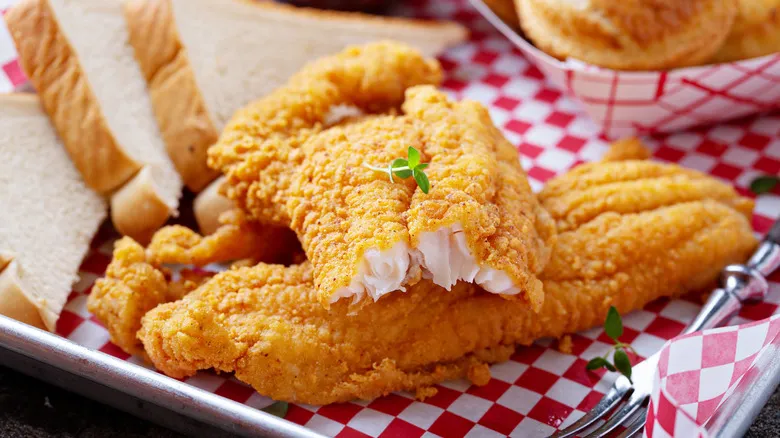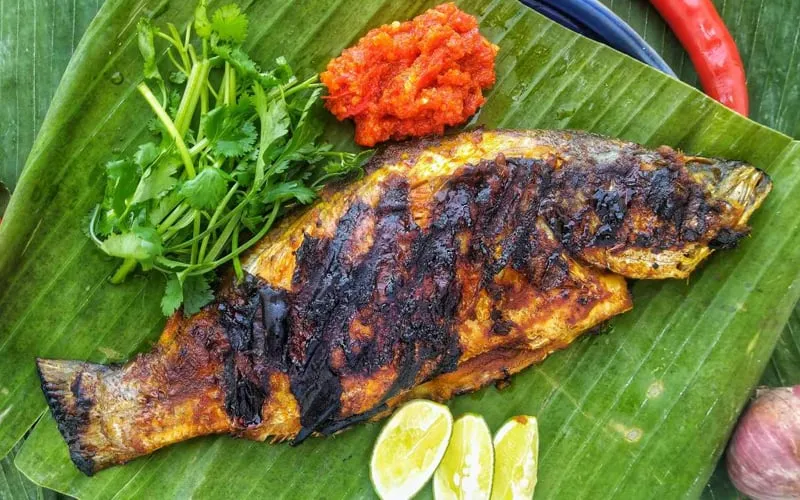The Best Fluffy Pancakes recipe you will fall in love with. Full of tips and tricks to help you make the best pancakes.
There’s nothing quite like the satisfying crunch of perfectly fried fish—golden, crispy on the outside, and tender on the inside. Whether you’re making a classic Southern-style fish fry, a beer-battered favorite, or a simple pan-fried dish, the key to perfection lies in the right fish, batter, and frying techniques.
In this guide, we’ll walk you through everything you need to know to achieve the ultimate crispy fried fish. From selecting the best type of fish and mastering the perfect batter to frying tips and delicious side dishes, this post will help you create a restaurant-quality fish fry at home. Get ready to impress your family and friends with a fish fry that’s crunchy, flavorful, and absolutely irresistible!
Choosing the Best Fish for Frying
The type of fish you choose plays a major role in achieving the perfect fried fish. Not all fish are suited for frying, as some have too much moisture, while others may be too delicate and fall apart during cooking. Here’s what you need to know to pick the best fish for frying.

Best Whitefish Options for Frying
When frying fish, you want a firm, mild-flavored whitefish that holds up well to high heat and develops a crispy crust. Some of the best options include:
- Cod – A popular choice known for its flaky texture and mild taste. It absorbs seasoning well and gets beautifully crispy when fried.
- Haddock – Similar to cod but with a slightly sweeter taste, haddock fries up well and pairs perfectly with cornmeal or beer batter.
- Tilapia – A budget-friendly option with a neutral flavor, making it great for seasoning and frying.
- Catfish – A Southern favorite with a firm texture and naturally sweet flavor, perfect for cornmeal dredging and deep-frying.
- Pollock – Often used in fish sticks and fast-food fish sandwiches, this fish has a firm texture and mild taste that works well when fried.
Fresh vs. Frozen Fish: What Works Best?
- Fresh fish is always ideal for frying as it retains its natural texture and moisture. Look for fish with bright eyes, firm flesh, and a fresh, clean smell.
- Frozen fish can also be used, but it must be thawed properly to prevent excess moisture, which can make the batter soggy. The best way to thaw fish is by leaving it in the refrigerator overnight or placing it in cold water for a quick thaw.
Preparing Your Fish for Frying
Before frying, it’s crucial to prepare your fish properly to get the crispiest results:
- Pat the fish dry – Excess moisture can cause the batter to slide off or become soggy. Use paper towels to pat the fish dry before seasoning and coating.
- Remove bones and skin (if necessary) – Some people prefer skin-on fish for extra texture, while others like it skinless. If using skin-on fish, make small slits on the skin to prevent curling during frying.
- Cut into even portions – For uniform cooking, ensure your fish fillets or pieces are of similar size and thickness.
By choosing the right fish and preparing it correctly, you’ll set yourself up for a crispy, flavorful, and perfectly fried dish every time. Now, let’s move on to the secret behind making the perfect batter!
The Secret to the Perfect Fish Fry Batter
A perfectly crispy fish fry starts with the right batter. The texture, flavor, and crunch of your fried fish depend on how well the batter adheres and how it reacts to the frying process. The right combination of ingredients and techniques will give you that irresistible golden crunch. Here’s how to create the perfect fish fry batter.
Flour vs. Cornmeal: Which One Gives the Best Crunch?
The choice between flour and cornmeal (or a combination of both) determines the texture of your fried fish. Here’s a breakdown of each option:
- Flour-Based Batter: Using all-purpose flour results in a lighter, more uniform crust. It works well when combined with wet ingredients like beer or buttermilk to create a smooth, even coating.
- Cornmeal Coating: If you prefer a Southern-style crispy crust, a cornmeal-based coating is ideal. Cornmeal gives the fish a coarser, crunchier texture and pairs well with catfish and tilapia.
- Combination of Flour and Cornmeal: For the best of both worlds, many recipes use a mix of flour and cornmeal. The flour helps the batter stick to the fish, while the cornmeal adds crunch. A common ratio is 1:1 or 2:1 (flour to cornmeal).
Adding Seasonings: Enhancing Flavor in Every Bite
Seasoning your batter is crucial for flavorful fried fish. A bland batter can leave your dish tasting flat, so make sure to add these essential spices:
- Paprika – Adds a mild smokiness and enhances color.
- Garlic powder & onion powder – Boosts savory depth.
- Cayenne pepper – Gives a subtle kick of heat. Adjust based on your spice preference.
- Salt & black pepper – Essential for enhancing overall taste.
- Old Bay seasoning – A classic seafood seasoning that brings out the best flavors in fried fish.
For extra crunch and an even crispier texture, you can also mix in panko breadcrumbs with your flour and cornmeal mixture.
Using Buttermilk or Beer for Extra Crispiness
Adding a liquid component to your batter can make a big difference in the texture:
- Buttermilk Soak: Soaking fish in buttermilk before dredging in flour/cornmeal helps tenderize the fish and adds a subtle tangy flavor. It also helps the coating adhere better.
- Beer Batter: Beer adds airiness and lightness to the batter, creating a crispier crust. The carbonation in the beer helps the batter puff up when fried, giving a crunchy, golden exterior.
- Egg Wash: Some recipes use an egg wash (whisked egg with a little milk) before dredging in dry ingredients. This helps bind the coating and makes it extra crispy.
By choosing the right base, seasoning it well, and incorporating the right liquid, you can achieve a perfectly crispy, golden-brown fish fry every time. Now that your fish is prepped and coated, let’s move on to the best frying techniques for a flawless finish!
Frying Techniques for a Crispy and Golden Finish
Getting the perfect crispy fried fish isn’t just about the batter—it’s also about the frying technique. The right oil, temperature, and cooking method all play a crucial role in achieving a golden, crunchy crust while keeping the fish tender and juicy inside. Follow these expert tips to ensure your fish fries up perfectly every time.
Deep Frying vs. Pan Frying: Pros and Cons
There are two main ways to fry fish: deep frying and pan frying. Each method has its own benefits, depending on the texture and flavor you’re looking for.
- Deep Frying:
- Pros: Ensures an even, crispy coating all around the fish. Best for thick fillets or heavily battered fish.
- Cons: Uses more oil, requires a fryer or deep pot, and can be messy.
- Tip: Use a deep fryer or a Dutch oven to maintain a consistent temperature.
- Pan Frying:
- Pros: Requires less oil, is easier to manage, and works well for thinner fillets.
- Cons: Doesn’t provide an even crisp on all sides, and fish needs to be flipped.
- Tip: Use a cast-iron skillet for the best heat retention and even browning.
If you prefer a healthier option, you can also use an air fryer to achieve a crispy texture with minimal oil.
Choosing the Right Oil for Frying
The type of oil you use can significantly impact the flavor and crispiness of your fried fish. The best oils for frying have a high smoke point to prevent burning and unwanted flavors. Some of the best options include:
- Peanut Oil: Provides a light, nutty flavor and maintains a high frying temperature.
- Canola Oil: A neutral-flavored oil with a high smoke point, great for deep frying.
- Vegetable Oil: Affordable and widely available, making it a common choice for frying.
- Corn Oil: Enhances the flavor of cornmeal-breaded fish.
- Lard or Shortening: Traditional options for an old-school Southern fish fry, giving a rich and crispy crust.
Ideal Frying Temperature for the Best Crunch
One of the most critical factors in frying fish is keeping the oil at the right temperature.
- The ideal frying temperature is between 350°F and 375°F (175°C-190°C).
- If the oil is too hot, the coating will burn before the fish is cooked through.
- If the oil is too cold, the fish will absorb excess oil, resulting in a greasy texture.
How to maintain the right temperature:
- Use a candy or deep-fry thermometer to monitor the oil.
- Let the oil heat properly before adding fish—test by dropping a small piece of batter in the oil; it should sizzle and float immediately.
- Avoid overcrowding the pan, as this lowers the oil temperature and leads to soggy fish.
Frying Tips for a Perfectly Crispy Coating
- Dredge just before frying: Coat the fish in batter or flour/cornmeal right before placing it in the hot oil to prevent sogginess.
- Gently place fish into the oil: Avoid splashing by lowering the fish carefully using tongs.
- Flip only once (for pan frying): Let the fish cook undisturbed until golden brown before flipping to maintain a crisp crust.
- Drain excess oil properly: Place fried fish on a wire rack over a baking sheet instead of using paper towels. This prevents steaming and keeps the crust crispy.
By using the right frying method, oil, and temperature, you’ll achieve a perfectly crispy and golden fish fry every time. Now, let’s explore the best side dishes to serve with your delicious fried fish!
If you’re looking for a lighter alternative to traditional frying, an air fryer can be a great option. It uses hot air circulation to achieve a crispy texture with significantly less oil. A top choice is the Ninja Air Fryer (AF181), which allows you to fry, roast, and dehydrate foods with precision.
Delicious Side Dishes to Serve with Fried Fish
A perfectly crispy fried fish deserves equally delicious side dishes to complete the meal. Whether you want something classic, fresh, or bold in flavor, the right side dish can enhance the taste and balance the richness of the fried fish. Here are some of the best side dishes to serve with your fish fry.

Classic Southern Sides for a Traditional Fish Fry
A classic fish fry wouldn’t be complete without some comforting Southern favorites. These traditional sides bring out the best in fried fish and create a well-rounded, satisfying meal.
- Coleslaw: A creamy, tangy coleslaw made with shredded cabbage, carrots, and a mayonnaise or vinegar-based dressing adds a refreshing contrast to crispy fish.
- Hush Puppies: These deep-fried cornmeal fritters are a staple at any fish fry. Lightly sweet and crispy on the outside, hush puppies are the perfect complement to fried fish.
- Cornbread: Sweet, buttery cornbread pairs wonderfully with fish, adding a soft texture that balances the crunch of the fish. Serve with honey butter for extra flavor.
- Mac and Cheese: Creamy, cheesy, and comforting, mac and cheese provides a rich and delicious contrast to the crispy, flaky fish.
Fresh and Light Sides to Balance the Crispy Fish
Since fried fish can be rich and crispy, pairing it with light, fresh sides can help balance the meal and add a refreshing touch.
- Garden Salad: A simple mixed greens salad with a light vinaigrette can cut through the richness of fried fish, offering a crisp and refreshing contrast.
- Cucumber and Tomato Salad: A chilled cucumber and tomato salad with red onion, olive oil, and vinegar adds a burst of freshness to the meal.
- Steamed or Roasted Vegetables: Lightly seasoned roasted or steamed vegetables, such as asparagus, green beans, or Brussels sprouts, bring a healthy and flavorful touch.
- Lemon Herb Rice: A light and fragrant rice dish with lemon zest and fresh herbs (such as parsley or dill) pairs well with fish, keeping the meal light and fresh.
Comforting and Hearty Sides for a Filling Meal
If you’re looking for a more satisfying and hearty meal, these side dishes will make your fish fry even more filling and enjoyable.
- French Fries or Sweet Potato Fries: Crispy fries, whether classic or made with sweet potatoes, are a perfect match for fried fish. Serve with tartar sauce or ketchup for dipping.
- Mashed Potatoes with Gravy: Creamy mashed potatoes, either classic or with a touch of garlic, make for a comforting side dish that pairs well with fried fish.
- Baked Beans: Sweet and smoky baked beans add a delicious depth of flavor that complements crispy fried fish beautifully.
- Grits: A bowl of buttery grits or cheesy grits provides a creamy, smooth texture that balances the crunch of the fried fish.
Sauces and Condiments to Elevate Your Fish Fry
No fish fry is complete without the right sauces and condiments to enhance the flavors.
- Tartar Sauce: A classic dipping sauce made from mayonnaise, pickles, lemon juice, and herbs adds a creamy, tangy contrast to fried fish.
- Remoulade Sauce: A spiced-up version of tartar sauce, remoulade includes mustard, paprika, capers, and hot sauce for an extra kick.
- Lemon Wedges: Fresh lemon juice squeezed over fried fish brightens up the flavors and cuts through the richness.
- Hot Sauce: A splash of your favorite hot sauce can add just the right amount of heat to your crispy fish.
By pairing your fried fish with a mix of crispy, creamy, and refreshing side dishes, you’ll create a well-balanced and mouthwatering meal that’s sure to impress. Now, let’s explore some final tips for making your fish fry a success!
Pro Tips for the Best Fish Fry Every Time
Mastering the perfect fish fry requires more than just the right batter and oil—it’s about technique, timing, and small details that make a big difference. Whether you’re cooking for a family gathering, a weekend fish fry, or just craving crispy, golden fish, these expert tips will help you get it right every time.
1. Use Fresh or Properly Thawed Fish
The quality of your fish is crucial to achieving a delicious result. Always opt for fresh fish when possible, but if using frozen, make sure to thaw it correctly.
- Fresh Fish: Look for fish with clear eyes, a mild ocean scent (not fishy), and firm flesh.
- Frozen Fish: Thaw in the refrigerator overnight rather than using a microwave or soaking in water, which can make the fish mushy. Pat dry with paper towels to remove excess moisture before battering.
2. Pat the Fish Dry Before Battering
One of the biggest mistakes when frying fish is not drying it properly before coating it with batter or breading. Excess moisture can cause the batter to slip off and make the fish steam instead of crisp up.
- Use paper towels to gently press and remove any excess moisture from the fish.
- If necessary, lightly coat the fish with flour before dipping it into the batter to help the coating stick better.
3. Let the Batter Rest for Extra Crispiness
If you’re using a batter (rather than a dry breading), allowing it to rest before frying can make a noticeable difference in texture.
- Let the batter sit for 10-15 minutes to allow the ingredients to combine properly and create a better coating.
- If using a beer batter, chilling it for a short time can help make the crust lighter and crispier.
4. Maintain the Right Oil Temperature
Oil temperature is one of the most important factors in achieving a crispy, golden fish fry.
- Ideal Temperature: 350°F – 375°F (175°C – 190°C)
- Use a deep-fry thermometer to ensure accuracy. If the oil is too cool, the fish will absorb too much oil and become greasy. If too hot, the batter will burn before the fish is cooked through.
- Avoid overcrowding the pan, as it lowers the oil temperature and prevents even frying.
5. Fry in Small Batches for Consistency
To ensure even cooking and the crispiest results, always fry fish in small batches.
- Overcrowding can cause temperature drops, leading to soggy fish.
- Fry only 2-3 pieces at a time, giving them enough space to crisp up evenly.
6. Flip at the Right Time (for Pan Frying)
If pan-frying, resist the urge to constantly flip the fish.
- Let one side cook undisturbed for about 3-4 minutes before flipping.
- Flip only once to maintain a crispy crust.
7. Drain on a Wire Rack Instead of Paper Towels
After frying, proper draining is essential to keeping the fish crispy.
- Place the fried fish on a wire rack over a baking sheet rather than on paper towels, which can trap steam and make the crust soggy.
- If you need to keep fish warm before serving, place it in a low-temperature oven (200°F/95°C) on a wire rack until ready to serve.
8. Season Immediately After Frying
For extra flavor, always season the fish with a light sprinkle of salt or seasoning mix right after it comes out of the oil.
- This helps the seasoning adhere to the crispy crust while it’s still hot.
- Consider adding a dash of cajun seasoning, lemon zest, or garlic powder for extra flavor.
9. Experiment with Different Coatings and Batters
While classic cornmeal or flour-based coatings are always great, experimenting with different batters can bring unique textures and flavors.
- Panko breadcrumbs – Extra crispy and light
- Crushed crackers or cornflakes – Adds a crunchy texture
- Beer batter – Creates an airy, crispy crust
- Tempura batter – Light and extra crispy with a delicate crunch
10. Serve Immediately for the Best Texture
Fried fish is at its best when served hot and fresh.
- If you need to prepare large batches, stagger your frying times to ensure fish stays warm and crispy.
- Serve with lemon wedges, tartar sauce, or your favorite dipping sauces to enhance the flavors.
By following these pro tips, you’ll be able to achieve perfectly crispy, golden, and flavorful fried fish every time. Now, it’s time to gather your ingredients and get frying!






[…] Fried Fish: A simple fried fish, such as red snapper or tilapia, can be a fantastic addition to Arroz con Gandules. The crispy, golden crust of the fish adds a delightful crunch, while the soft, flaky interior pairs nicely with the richness of the rice. Serve the fish with a squeeze of lime for a fresh and zesty contrast. […]